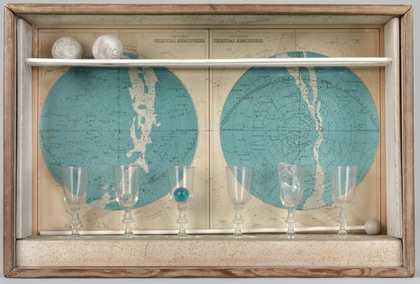Joseph Cornell (1903–1972) was revered in his lifetime as a modern American master. He had no formal training in art but, influenced by surrealism, he began making collages and boxed assemblages in the early 1930s. Throughout his life he read voraciously about the great figures of European romanticism and symbolism. However, this diffident bachelor, who never travelled far from the home he shared with his mother and invalid brother in the suburbs of New York, found inspiration not only in the romantic ideals of a distant age but also in prosaic, everyday objects and materials. With items found in local junk shops and dime stores – cheap reproductions, maps, toys, marbles, springs, feathers, sequins – he created boxes filled with fantasy and longing. His poetic sensibility was recognised by many in the late 1950s as original and unique, albeit one not in tune with the prevailing artistic tendencies of the day. Reviews of his first major retrospective held at the Guggenheim Museum, New York, in 1967 hailed the show as ‘an exhibition of unforgettable beauty’ and described Cornell himself as ‘legendary’.1
Intensely private and repressed, Cornell did not court publicity and shied away from direct or probing questioning about his work. In his home he often refused to show his constructions to visitors whom he did not think capable of responding sympathetically to them. Many visitors felt that he lived in a world of his own. Diane Waldman, a long-term friend and curator of the Guggenheim retrospective, noted of her somewhat disjointed conversations with him, ‘He would digress from the most insignificant comment to the most meaningful one, following a train of thought that abruptly shifted gears, precise at one moment, obscure the next.’2 As a result, many critics and writers who knew Cornell found it difficult, even contrary to the spirit of the work, to attempt to classify it or to place it in a context beyond that of the artist’s inner life. In what was a typical response, Waldman wrote in 1977, ‘Cornell’s dreams, locked within glass-panelled boxes are deeply personal and ultimately elusive. Mystery is the essence and substance of his work.’3
While not necessarily departing from this view, later writers have attempted to offer various interpretative contexts for Cornell’s work, emphasising variously his indebtedness to surrealism, his links to American modernism, the role of commonplace Americana in his work and the importance of his faith in Christian Science. All have been immeasurably helped in their task by the availability after Cornell’s death of his diaries and of his dossiers of notes and boxes of source materials, now held at the Archives of American Art and the Joseph Cornell Study Center, Washington D.C. These documents have allowed writers to understand Cornell’s painstaking attempts to explore the sources of creativity within him and to create some sort of order from them through his art.
In particular, these materials have offered invaluable insights into Cornell’s thoughts and working processes. His files of documents on subjects ranging from Cassiopeia to the actress Claire Bloom, show that he collected materials relating to subjects that interested him over many years. Some dossiers led to the eventual creation of one or more art works; others did not, at least, not in any obvious way. Within this heterogeneous material, however, Cornell spun a web of associations that cannot now always be followed or reconstituted, and his boxes – distillations of private experiences and thoughts – often conceal the richness of ideas that went into their making. Cornell was well aware of this, and in October 1950 wrote with regret of his ‘intense longing to get into the boxes this overflowing, a richness & poetry felt when working with the boxes but which has often been completely extraneous in the final product’.4 In many ways, his notes and dossiers were also distillations of experiences and thoughts that were deeply personal, perhaps too personal to be fully understood today.
The difficulties of coming to understand Cornell and his work in detail are illustrated by the box which has long been known as Giuditta Pasta (dédicace), 1950, owned by Tate (fig.1). This box was acquired in 1974 as Giuditta Pasta from a gallery in New York acting on behalf of an anonymous private collector. With the artist recently dead and his sister unable to offer any information about this work, it proved difficult to explore this construction in any depth at the time. The previous owner would only confirm that he or she had purchased the box from Cornell’s exhibition Night Songs and Other New Work – 1950 by Joseph Cornell, held at the Egan Gallery in December 1950, and had not lent the work thereafter. There was no literature on the piece, and although the Tate Gallery published a short catalogue entry on the box shortly after its purchase,5 there has been no critical discussion of this particular work to this day.
Closer examination, however, reveals that Cornell intended the box to have a slightly different title. On its reverse are three labels (figs.2–4). One, typed presumably by Cornell himself, gives detailed instructions about the placement of the two marbles and a piece of quartz in the glasses within the box. Another has a child’s stick-on purple, spangly star and the typed inscription ‘Giuditta Pasta (dédicace)’, indicating clearly that the box was dedicated to the nineteenth-century opera singer. However, in the centre, is a label bearing both a typed and signed signature of the artist and the typed inscription ‘Planet Set | Tête Etoilée’ (fig.5). When the box was acquired, the decision was made to retain the shorter title by which the box was then known, but it seems more appropriate to use all three inscriptions sanctioned by Cornell, beginning with those on the label signed by the artist himself.6 Many Cornell boxes have similarly complex titles, for example, Untitled (Medici Boy), 1942–52, A Pantry Ballet (for Jacques Offenbach), 1942, Untitled (Hôtel de l’Etoile: The Diplomacy of Lucile Grahn), circa 1953, and Custodian II (Silent Dedication to MM), 1963.
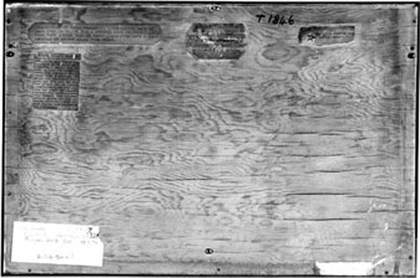
Fig.2
Joseph Cornell
View of reverse of Planet Set showing disposition of labels
© The Joseph & Robert Cornell Memorial Foundation/VAGA, New York and DACS, London 2004

Fig.3
Joseph Cornell
Close-up of label at top left giving detailed directions about the placement of the elements of Planet Set, typed presumably by Cornell. Underneath it is the press cutting cited at the end of the article
© The Joseph & Robert Cornell Memorial Foundation/VAGA, New York and DACS, London 2004
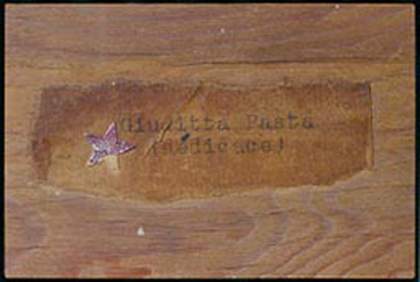
Fig.4
Joseph Cornell
Close-up of label at top right with dedication to Giuditta Pasta, typed presumably by Cornell
© The Joseph & Robert Cornell Memorial Foundation/VAGA, New York and DACS, London 2004
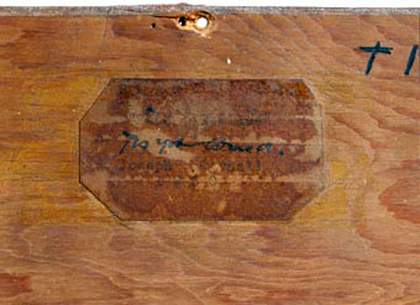
Fig.5
Joseph Cornell
Close-up of central label with typed and handwritten signature by Cornell and the now scarcely decipherable words ‘Planet Set’ and ‘Tête Etoilée’
© The Joseph & Robert Cornell Memorial Foundation/VAGA, New York and DACS, London 2004
If this retitling makes clear that the box is not, as it were, a symbolic portrait of Giuditta Pasta but is rather a work on a planetary theme dedicated to her, questions about the meaning of the dedication remain. Why was Cornell interested in this, now little known, singer and why did he dedicate this particular box to her? In what way, if any, does this box – with its map of the northern and southern celestial hemispheres, two wooden balls that are free to roll on dowling rods, a wooden stick and six liqueur glasses with a transparent marble, a slightly bigger blue marble and a piece of fused quartz – relate to Pasta?
Music and, in particular, the opera were important to Cornell throughout his life, though this is an area within Cornell studies that is much less explored than his passions for nineteenth-century Romantic ballet or for contemporary movie stars. Perhaps, as his biographer Deborah Solomon has suggested, this is because it was so often a hidden rather than overt subject of his boxes.7 As we shall see, music and singing are implied in his many boxes with birds and, through the concept of the ‘music of the spheres’, may have always have been an undercurrent within his many works on celestial themes. (The celestial theme is evoked here not only by the star charts but also by the two balls that are free to roll on the rods in the upper section of the box, creating new ‘alignments’, just as planets orbit a sun (fig.6).

Fig.6
Joseph Cornell
View of left-hand side of Planet Set showing the two wooden balls. Although the box is typically displayed so that the balls sit in the position recorded here in the official view of the work, the balls can and do move freely when the box is handled
© The Joseph & Robert Cornell Memorial Foundation/VAGA, New York and DACS, London 2004
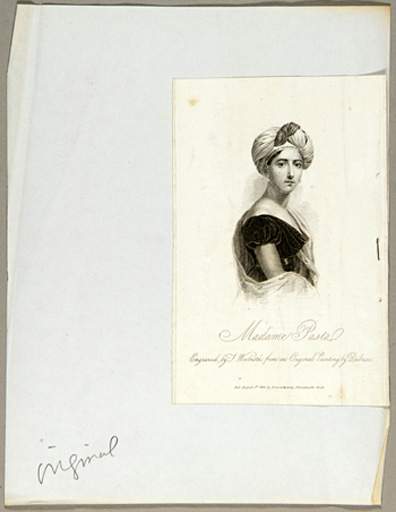
Fig.7
Portrait of Giuditta Pasta included in Joseph Cornell’s Giuditta Pasta Dossier 1940s–1960s
Joseph Cornell Study Center, Smithsonian American Art Museum, Gift of Mr And Mrs John A. Benton © The Joseph & Robert Cornell Memorial Foundation/VAGA, New York and DACS, London 2004
Cornell seems to have discovered Giuditta Pasta (1797–1865) (fig.7) when he came across a lithographic portrait of her while browsing in a store in Fourth Avenue circa 1942 (he was later to say that the 1940s had been a golden age for making such discoveries). His vision of Pasta was entwined with a passionate interest in other opera singers of the period, notably Pasta’s rival Maria Malibran (1808-36). Entries in his diaries – one as late as the year of his death in 1972 – indicate that Cornell never forgot the experience of hearing opera, in particular, arias from Rossini’s The Barber of Seville, during a vacation in the Adirondack mountains, north of New York, in 1921. As he would have known through his research, this opera was associated with both Pasta and Malibran.8 Rossini created the role of Count Almaviva in this opera for the father of Malibran, and, curiously, she first performed in public when, aged only seventeen, she sang the part of Rosina in the opera as a replacement for Pasta when the latter was taken ill. Shortly afterwards Malibran came to America in a troupe that was the first to sing Italian opera in New York. For pleasure Cornell once read out to his invalid brother an account of Maria’s first performance in New York.9 A third figure in Cornell’s operatic pantheon was Malibran’s sister Pauline Viardot-Garcia (1821–1910), who later became a famous mezzo singer in her own right. Pauline composed operettas to the libretti of her great admirer, Russian author Ivan Turgenev, and was the protegée of the author George Sand. A fourth figure was Giulia Grisi (1811–1869) who, like the more famous Pasta and Malibran, practised the virtuoso and florid type of singing known as bel canto.
These divas – superstars of their age – captured Cornell’s imagination: he referred to them frequently in his diaries, created dossiers about them and dedicated several works to them. To a large extent they were feminine muses similar to the ballerinas and modern film stars he also worshipped from afar. Significantly, Pasta was represented – albeit chiefly through a single lithographic portrait – in his 1946 exhibition Romantic Museum at the Hugo Gallery: Portraits of Women by Joseph Cornell, alongside his homages to such other female performers of the past as Maria Malibran and the ballerina Fanny Ceritto, and such contemporary stars as Lauren Bacall and Greta Garbo. For Cornell these muses conveyed through their being an ideal of feminine beauty and through their artistry as performers a spiritual purity and emotional veracity – qualities that he felt ennobled human existence.
His works dedicated to the long dead and almost forgotten divas of a past age can be seen as homages, offered as chivalrous gesture of remembrance and an attempt to make amends for modern neglect. They were also a conscious use of history, or more exactly, individual experiences of the past, as a source of inspiration. In a note in the Pasta dossier he talked about the value of focusing on the little known, secondary figures rather than the great personages and major events of history: ‘”taking offensive”’ with own viewpoint such as developed in “unauthorised biographies” – Cerrito, Pasta – is it not more refreshing & stim. [stimulating] than the endless “Why Waterloos”’, he asked.10 In a diary entry of 28 February 1960, in which he mused about his obsession inter alia with Pasta, he wrote: ‘”Heritage of Memory” as stimulant and inspiration to the young vs. dead hand of abstract expressionism.’11 Developing this theme of the Cornell’s interest in the spirit of particular individuals, it may be possible to suggest that the cordial glasses found in so many of Cornell’s works represented, at some level, human beings as vessels. If so, it might be possible to suggest also that the presence of the blue marble in one of the glasses which echoes the colour and shape of the celestial hemispheres, indicates a resonance of sorts between the heavens and the individual, or type of individual, represented by the glass.
Of course, in his appreciation of singers of the distant past Cornell depended largely upon the written accounts of contemporaries. Here Pasta was particularly well served by the adoration she aroused in the French writer Stendhal (1783–1842). Stendhal wrote passionately about the qualities of her voice and expression of heartfelt emotion that, he claimed, made her performances both electrifying and spiritually uplifting. ‘Where should I find words’, he wrote in the chapter on Pasta in his 1823 biography of Rossini, ‘adequate to describe the vision of celestial beauty which spread before us in dazzling glory when Madame Pasta sings, or the strange glimpses into the secrets of sublime and fantastic passions which her art affords us?’12 Developing this celestial theme, Stendhal quoted at length the words of another admirer of Pasta, a young Neapolitan man who compared the associations conjured in him by her voice with those aroused in him by the starry night sky in Italy:
This wondrous voice, with its swift succession of tones which shift like shadow chasing sunlight, seems to distil a rare quintessence of delight and memory, conjuring up the half-forgotten softness of the night in our unhappy land – of those pure, crystalline nights, when the pattern of stars lay like a silver web across the deepest blue of the sky […] her voice, changing from register to register, inspires in me the same sensation as this memory of moonlight, veiled an instant, darker, softer, more entrancing … then shining forth anew, a silver shower a thousand-fold increased.13
Cornell knew this text (pages from it were included in his dossier on the singer), and it seems possible that the parallels drawn here between the feelings conjured by Pasta’s voice and by the beauty of a night sky had a bearing on the presence of the maps of the celestial hemispheres found in Tate’s box. Cornell himself made a similar connection, linking the sight of the zodiacal gold-on-blue representation of the heavens on the ceiling of Grand Central railway station with thoughts of various projects, including one on Giuditta Pasta, in a diary entry for 9 December 1948:
finished chores and rested in Grand Central waiting room until church time – elation at looking up at celestial blue heavens and golden constellations on the ceiling – thoughts of the Milky way star dust and scattering of bread crumbs in the morning for the birds at home […] In Grand Central thought anew about getting at the editions for various projects, ONDINE, Celestial Theatre, Gérard de Nerval, Pasta etc.14
The celestial maps in Planet Set can thus be seen as evoking more than the clichéd description of performers as ‘stars’. For Cornell, the wonderment experienced when looking at the stars was directly akin to the enjoyment of the sublime glory of the voice of a singer such as Pasta, as reported by Stendhal. Furthermore, as the profusion of millions of stars in the Milky Way evoked for Cornell the scattering of breadcrumbs for birds on the ground, there was a sense in which, for Cornell, the macrocosm was mirrored in the microcosm and vice versa. Within Cornell’s imagination there were hidden affinities to be found between the great and the humble, the distant and the near, the immaterial and the material. The traditional representation of the constellations as figures and animals (rendered in the nineteenth-century map used in this box with a curious mix of German and Latin names, though the map was printed in Edinburgh)15 was an example of this ancient way of thinking. For Cornell the contents of the liqueur glasses in this box – a transparent marble, a slightly bigger blue marble which is the same hue as the celestial maps behind it, and the unshaped piece of quartz – may have evoked in commonplace and material form aspects of the luminosity and vast space of the skies represented in the celestial maps behind them.
Another aspect of the theme of luminosity – as yet not fully explored – seems to have attached itself to the idea of Giuditta Pasta within Cornell’s mind. In his diary, on 30 August 1956, he referred to stories of the scintillating crown worn by Pasta when taking a curtain call for her role in Rossini’s opera Tancredi.16 In the Pasta dossier Cornell kept a page on which he had affixed a postcard of New York skyscrapers, showing a glint of reflected light on one edge of the central building (fig.8). This glint may have evoked for Cornell something of Pasta’s performances: he wrote under the postcard ‘”the tiara’s gleam” (Tancred)’. A diary entry would suggest that he first made an association between Pasta’s ‘couronne’ and a light seen in a skyscraper in the early 1950s.17 As we have seen, Pasta was associated with night skies in this mind in the late 1940s. By the mid 1950s, if not before, she was also associated with the idea of clouds and daytime blue skies seen in the city. On 10 June 1954 Cornell added to the Pasta dossier a note about his fascination with clouds in art and literature, noting that ‘own experience has been the “high noon” phases of the metrop. [metropolitan] skies – against clouds the buildings in full light in clear singing blue and dramatic movements of nature’.18 Two years later, on 31 August 1956, he noted in his diary, ‘home backyard – thinking back in this spot to CLOUDS and PASTA – countless days under stress of comfort from clouds’ and ‘Pasta confronted with my preoccupation with TANCREDI’.19
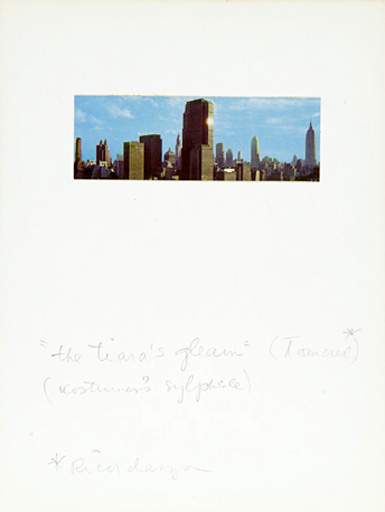
Fig.8
Page in Joseph Cornell's Giuditta Pasta Dossier 1940s-60s, with postcard of New York skyline and inscription by Joseph Cornell, '"the tiara's gleam" (Tancred*) (costumer's sylphide) *Ricordanza'
Joseph Cornell Study Center, Smithsonian American Art Museum, Gift of Mr And Mrs John A. Benton © The Joseph & Robert Cornell Memorial Foundation/VAGA, New York and DACS, London 2004
Another aspect of this association linking Pasta with light within Cornell’s mind is the idea of ‘la tête étoilée’, used as one of the titles of Tate’s box. As has been seen, the phrase can be seen as related to the crown worn by Pasta in her role of Tancredi, but there are also other possible readings. In the dossier there is a postcard of the Statue of Liberty who wears a crown of stars. Its presence is unexplained but may relate to either Pasta in the role of Tancredi or perhaps more generally to the traditional association of figures with constellations. It is also possible that the phrase ‘la tête étoilée’ was inspired, at least in part, by a section given this title in Calligrammes: Poems of Peace and War 1913–16 by the famous French poet Apollinaire. Significantly, there is a poem within this section titled ‘Un oiseau chante’, which compares a bird’s song, heard on the battlefields, to love.

Fig.9
‘Pasta’s Parrot’ included in Joseph Cornell’s Giuditta Pasta Dossier, 1940s–1960
Joseph Cornell Study Center, Smithsonian American Art Museum, Gift of Mr And Mrs John A. Benton © The Joseph & Robert Cornell Memorial Foundation/VAGA, New York and DACS, London 2004
Birds are a key element in Cornell’s multifaceted obsession with Pasta, and a major theme in his work as a whole. As already seen in a diary entry of 1948, he associated Pasta with constellations and the feeding of birds. In 1949 he had an exhibition at Egan Gallery titled Aviary, which was inspired in part by his memories of a neighbour’s pet parrot and by the sight of a window of a pet shop which had caged songbirds. Although the Tate’s box does not allude to birds, Cornell made other homages to Pasta that did. Aviary (for Giuditta Pasta), circa 1953–7, (private collection) for example, features a white cockatoo. Moreover, in the Pasta dossier he stamped the words ‘PASTA’S PARROT’ on a small manila envelope that was stapled onto an image of a white cockatoo (a cover of the magazine Natural History) (fig.9). This association may have been reinforced by a lithographic portrait of Pasta wearing a plumed helmet in her role as Tancredi that he kept in the dossier (fig.10).
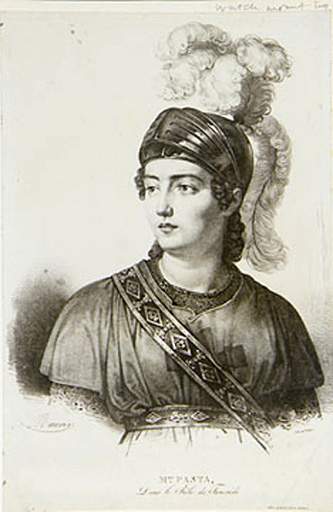
Fig.10
Giuditta Pasta in the role of Tancredi
Lithograph included in Joseph Cornell’s Giuditta Pasta Dossier, 1940s–1960s
Joseph Cornell Study Center, Smithsonian American Art Museum, Gift of Mr and Mrs John A. Benton © The Joseph & Robert Cornell Memorial Foundation/VAGA, New York and DACS, London 2004

Fig.11
Portrait of Maria Malibran with songbird 1840s
Sheet music with lithograph by Albert Newsam and P.S. Duval, Keffer Collection of Sheet Music circa 1790-1895; plate no.645
University of Pennsylvania Library
Cornell seems to have associated Pasta and other opera singers with the notion of their being ‘song birds’. Indeed, Maria Malibran was known in her lifetime as a ‘song bird’ (fig.11). In homage to her Cornell had printed privately in the mid 1950s a pamphlet called simply Maria. This told the story of a nightingale that sang a magical song and died, but not before passing its gift to a child. The child grew up to become the singer who graced the stage as Desdemona in Rossini’s Othello: the ‘queen of song’, Maria Malibran. (It is just conceivable that the maps stuck on the underside of the top part of the box showing the west and east coasts of the peninsula of Queensland, Australia, deliberately, if obscurely, evoked the notion of a ‘land of Queens’, as well as providing a west-east axis to counter, or complete, the north-south aspects of the celestial maps (fig.12).

Fig.12
The map affixed to the underside of the top of the box, showing the east and west coastlines of the peninsula of Queensland, Australia, joined to create a continuous coast
© The Joseph & Robert Cornell Memorial Foundation/VAGA, New York and DACS, London 2004
From the early 1940s to the late 1960s Cornell created around the historical figure of Giuditta Pasta a complex nexus of facts and deeply personal associations that add immeasurably in the richness of the themes of the box. Cornell, who in his diaries could and did list the sources and memories that he knew had been important for his thinking about particular topics – tried himself to resist the trap of interpreting his work in a reductivist fashion. In a diary entry of 1960 he listed next to a reference to Pasta in the margin what he termed ‘sources of inspiration’ but added the phrase, ‘not be made a formula of’.
In the 1950s and 1960s, however, Cornell’s highly personal web of associations was hardly known to contemporaries who struggled to find apposite terms with which to describe his works. Typically, critics focused on the strangeness and quaintness of the boxes, missing some of the ‘richness & poetry’ that had flowed into the making of Cornell’s constructions. The more perceptive, however, sensed that there was a great deal more to the boxes than met the eye. In this context it is interesting that on the reverse of Tate’s box is a further label – affixed by an unknown hand (see fig.3) – that on examination has proved to be a clipping of a review of the 1950 exhibition at which the work was first shown. It reads:
Boxes: whatever the strange category of Joseph Cornell’s new works at the Egan Gallery, they are captivating, enchanting, such epithets, no sooner than grabbed at, display their inadequacy. Toys of genius these shadow-boxes bedecked with astronomical adornments are. With wood and glue, with mirrors and old celestial navigation charts, airy little structures are turned into exquisite fantasies. They assault our sensibility obliquely. They are semi-surrealist gambits that miss coyness and frivolity by a margin, now large, now tiny. And they must be seen to be believed.

